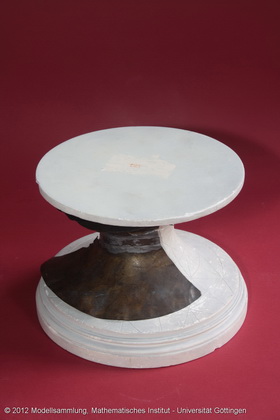Catenoid
Model 195
Description
Catenoid (rotational surface of the catenary)
Additions
This model represents a catenoid, a surface that arises by rotating a curve described by a hanging chain that is only supported by its ends, a so-called catenary. This is the surface that emerges from dipping two parallel, concentric wire circles into a soapy solution. A parametrization is given by the following formula: \[x(u,v)=c\cdot \cosh(\frac{v}{c}) \cos(u)\] \[y(u,v)= c\cdot \cosh(\frac{v}{c}) \sin(u)\] \[z(u,v)=v\ , \] where \(u,v \) are real parameters, and \(c\neq 0\) is a real constant.
Jean Baptiste Meusnier showed in the year 1776 that a catenoid is so-called minimal surface, a surface that locally minimizes its area. The catenoid is the only non-planar minimal surface of revolution.
The catenoid is part of a family of parameterized surfaces, it can be converted into the helicoid via continuous deformations.
Catenaries can be found both in nature and architecture, for example in a spiderweb or in the form of the Gateway Arch in St. Louis.
Showcase of this model is Case number 39
References
Schilling, Martin(Hrg.): Catalog mathematischer Modelle, Leipzig(Verlag von Martin Schilling) 1911, 7.Auflage, No.243. p. 147.
Separataband M4 im Mathematischen Institut p. 1.
Colding, M.(2011). A Course in Minimal Surfaces.
Eschenburg, J.(2007). Differentialgeometrie und Minimalflächen.


